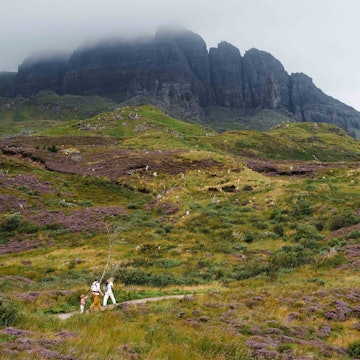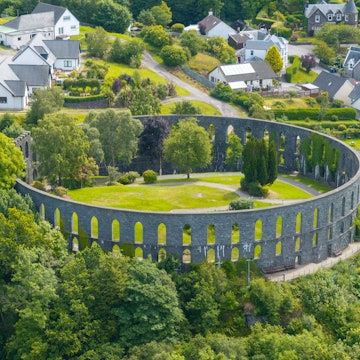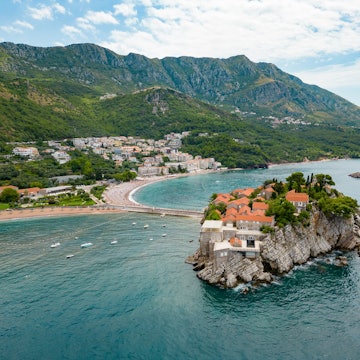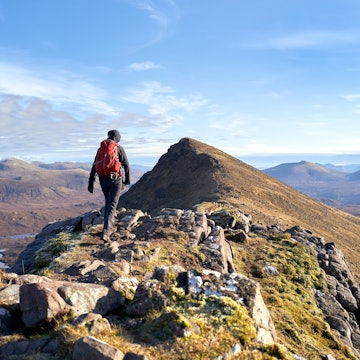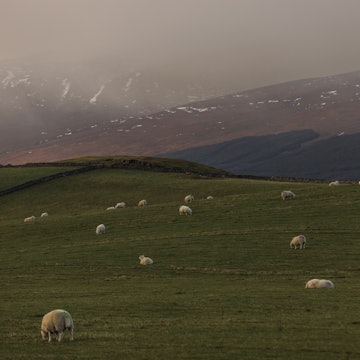
Explore the Outer Hebrides with this 8-day Scotland itinerary

May 12, 2025 • 13 min read

Beautiful beaches and rugged landscapes await in Scotland's Outer Hebrides. Helen Hotson/Shutterstock
What are you looking for from your Scotland itinerary? Souvenir shops and tartan hats, or uplifting Highland views, stone circles, cozy crofting communities and beaches with hardly a footprint on the sand? On an 8-day itinerary through the Outer Hebrides (Western Isles), you can dive into the real, untamed Scotland behind the clichés.
The coast of Scotland is studded with 790 islands, from tiny skerries inhabited only by squawking gulls to the hiker-thronged Isle of Skye, but this week-long tour focuses on one of the most beautiful island groups of them all. Forming a crescent off the west coast of Scotland, this chain of windswept islands is easily accessible from the Scottish mainland, but a world’s away from Scotland's crowds.
Traveling to the southernmost island of Barra by ferry, or on a thrilling flight landing on the beach at low tide, you can weave from island to island by car, bus or bicycle, using local ferries and causeways to go from island to island, exiting via Stornoway on the Isle of Lewis.
On the way, you’ll pass heart-stopping landscapes of exposed outcrops and loch-dotted peat marshes sliding onto white-sand beaches covered in lolling seals and seabirds, and drop into remote fishing and farming communities where Gaelic is still the favoured language.
If you’re ready for a real adventure, discover more on this classic 8-day Scotland itinerary linking the islands of the Outer Hebrides.
When to arrive
The west coast has a typical climate for Scotland – mild in the summer, fresh in the spring and fall, and cold, rainy and windy in winter. The best time to come is from May to September, but small biting midges can be a pest near water between June and August. Coming in May or September means cooler weather but fewer bugs.
If you plan to go camping, aim for the low-bug-count months in spring and fall. Cold water surfers favor the cooler months from October to March, when North Atlantic swells deliver excellent surf conditions around Eoropie Beach on Lewis and Hosta on North Uist. You’ll need at least a 6/5mm hooded wetsuit.

How to get around
Getting to and around the Outer Hebrides is easier than you might think, though not quite as easy as getting around on the Scottish mainland. It’s possible to fly into the Outer Hebrides via Barra at the southern end of the archipelago, or Stornoway in the north of Lewis, served by Loganair flights from Edinburgh, Glasgow, Inverness and Manchester.
If you fly into Barra, you’ll come in a small Twin Otter aircraft from Glasgow and land on the sand of a tidal beach on shallow Traigh Mhòr bay at the northern tip of the island – one of Europe’s more unusual flight routes. Pack light as there’s a 15kg baggage limit in the hold.
The other option is the Caledonian MacBrayne (CalMac) ferry. Ferries carrying cars, bikes and passengers run from Oban on the mainland to Barra (around five hours) and from Ullapool to Stornoway (around three hours).
If you plan to hire a car, they’re available in Stornaway and Barra, so you can drive straight on from the airport. Local operators are used to arranging one-way hires for people flying into one end of the island and out of the other.
If you’re content to use public transport, infrequent local buses run along the line of islands. Whether you travel by car or bus, you can cross between the islands via causeways or on interisland car ferries. Check bus timetables as most buses run in daylight hours and services stop on Sundays for religious reasons.
Cycling or walking the Outer Hebrides
Cycling the length of the Outer Hebrides along the 184-mile, on-road Hebridean Way is one of Scotland’s great pedal-powered adventures. There are steep uphill sections, gentle cruises and exhilarating descents into sand-sprinkled bays.
Hotels, B&Bs and bothies (simple huts for hire) line the route, and bikes can be carried for free on CalMac ferries (as can kayaks, if you‘re inclined to paddle along the coastline). For rental bikes, try Bike Hebrides in Stornoway.
Exploring on foot, the 156-mile Hebridean Way footpath traces a pedestrian-friendly path through the islands, with more beautiful scenery along the way. Whether you walk or cycle, most people travel from south to north because of the prevailing winds.
What to pack
You’ll want to bring warm layers at any time of year, plus waterproofs, which are better than an umbrella given the strong Atlantic winds. There’s a chance of rain year-round, and summer temperatures peak at around 16°C (61°F), so expect cool evenings and nights, even if days are warmer.
During the midge season, bring repellent and light-colored clothing with long sleeves; a hat with an insect net can be useful while hiking. You’ll need sturdy, waterproof footwear and spare dry socks – the ground is often marshy underfoot and you can expect to get wet feet at least once during your trip.

Day 1-2: Find your feet on a hike round Barra and Vatersay
Go to Barra: Ferries from Oban to Castlebay on Barra arrive in the afternoon, so on day one, you may just have enough time to walk along the foreshore and grab a glimpse of Kisimul Castle on its island in the bay, before you settle in for supper. Coming by air, you can arrive earlier and do more sightseeing on the first day.
How to spend the days: With two days (or an evening and a day) on Barra, start exploring on foot. From Castlebay, you can hike up Heaval, Barra’s highest point at 383m (1257ft). From the Our Lady of the Sea statue at the top, you’ll enjoy epic views over Castlebay, Kisimul Castle and the islands beyond.
Consider hiring a bike from Barra Bike Hire for the five-mile circuit around the island of Vatersay, linked to the coast near Castlebay by a causeway. A challenging uphill burst is rewarded by the stunning views of the twin beaches on the island – Traigh a Bhaigh and its neighbour Traigh Shiar.
If you stay near the airport in northern Barra, unleash your inner plane-spotter and watch the famous beach flight arrive on the sand at Barra Airport. With a vehicle, you can explore the west coast and the seal-dotted beaches around Borve and Allasdale.
Evening: Castlebay has the best choice of places to eat. Try the Castlebay Hotel restaurant for classic Scottish fare, or the Kisimul Cafe for seafood curries and other Punjabi treats.

Day 3: Explore Eriskay and South Uist
Go to Eriskay: Pre-book your vehicle onto the 40-minute CalMac ferry crossing from Ardmhòr on Barra to the small island of Eriskay.
How to spend the day: Devote a day to soaking up the sights and sands of Eriskay and South Uist. Before you come here, read up on the events that inspired the film Whisky Galore! – when whisky bottles from a wrecked freighter caused a flotsam-scavenging frenzy.
On arrival in Eriskay, stop at The Politician bar, just back from the beach, to see a whisky bottle and other memorabilia from the famous shipwreck. Before continuing north across the causeway, take a walk on Coilleag a Phrionnsa – aka the “Prince’s Beach” – where Bonnie Prince Charlie first set foot on Scottish soil in 1745.
Once you reach South Uist, you can book a paddleboard through Uist Sea Tours in Lochboisdale to explore the craggy shoreline, or join one of their tours to visit the puffin-crowded island of Mingulay, in the far south of the Outer Hebrides.
Alternatively, explore by land on a unique tour with Long Island Retreats, featuring its croft and resident ponies, or roam around the island to check out the lovely, isolated sandy beaches along the western shoreline. Backed by a sheet of machair (coastal grassland), the beaches here offer an almost Caribbean blend of white sand and turquoise waters.
On your way up the South Uist coast, delve into the island’s history and culture at the Kildonan Museum – an institution deeply embedded in the local community.
Evening: If you’re staying on Eriskay, The Politician does good suppers, or try the friendly Kilbride Cafe or the Polochar Inn, near the start of South Uist's beach strip. At the north end of the island, the Orosay Inn has a good reputation for fish and locally caught crustaceans.

Day 4: Discover Benbecula and North Uist
Go to Benbecula: The South Ford Causeway leads you north from South Uist to the low-lying island of Benbecula across a shallow, sandy bay.
How to spend the day: As you cross onto Benbecula, scan the shoreline and machair for otters and birds of prey. Rising to just 124m (407ft) at its highest point, the mini-mountain of Rueval, this marshy, pool-covered island is an ideal hunting habitat for predators such as the hen harrier, short-eared owl and merlin, and a rare breeding site for the red-necked phalarope.
You can hike up Rueval for views over an empty, waterlogged landscape, with the sloping ridges on the east coast of North Uist rising in the distance. Other ways to keep busy include looking for otters at Loch a 'Chinn Uacraich in Griminsh (sightings are quite common), and taking a horse ride along Benbecula’s western beaches.
Another causeway leads across to North Uist via the island of Grimsay, passing the bayside Gramsdale Standing Stones. Pause as you cross Grimsay – while the landscape is empty and exposed, dotted farmhouses add a cozy counterpoint to the island’s melancholy mood.
On North Uist, birding again takes center stage. Visit the RSPB Balranald Nature Reserve for a fresh-air fix and abundant birdlife. Listen out for the rasping cry of the corncrake and scan the water’s edge for red-necked phalaropes and the skies for hovering birds of prey.
While the terrain may seen inhospitable, humans have eked a living here for millennia. Find out more at the 5000-year-old chambered cairn (neolithic burial monument) of Barpa Langais and the nearby Pobull Fhinn stone circle.
If you’re feeling brave, sandy Traigh-stir beach at Hosta receives some of Scotland’s best surf from October to March, but you’ll need your own gear. Inland, about two miles east of the cross-island A865 road, is a viewpoint atop Clettreval Hill from where you can glimpse distant St Kilda. This lonely isle was home to the most remote community in Scotland until it was evacuated in 1930.
Evening: As night falls, head to the cosy Westford Inn in Claddach Kirkibost for a hearty meal based on seafood and real ale, or try Langass Lodge near Loch Eport for quality modern Scottish cuisine.

Day 5-6: Enjoy beautiful beaches on the Isle of Harris
Go to Harris: To catch the ferry to Leverburgh on the Isle of Harris, you’ll need to cross one more causeway to the tiny island of Berneray, known for its idyllic beaches and basking seals.
How to spend the days: Catch the mid-morning or lunchtime ferry to Harris and there’ll be time to go seal spotting on Berneray’s long, exposed West Beach, or the more sheltered East Beach, and swing by the Clach Mhor standing stone. You can grab lunch at Berneray Shop & Bistro.
Actually the southern third of the island of Lewis and Harris, Harris is small but incredibly varied. As you travel its short length, you’ll encounter three very different landscapes – imposing mountain peaks in the north, extraordinarily idyllic beaches on the southwest coast, and the stark, moonlike terrain of the southeast.
Stop in Leverburgh to shop for local small-batch beer at the Isle of Harris Brewery, or head to the enchanting A S Apothecary for luxurious skincare products and to sample the alcohol-free wellness spirit, Wild Eve, crafted from home-grown and wild-harvested plants, petals and botanicals.
Continue to the charming, medieval St Clement’s Church in Rodel, then choose whether you want to head north along the east coast via the Golden Road – a twisting and turning route through a wild landscape of grey rock and tiny lochans – or follow the more popular route along the beach-dusted west coast. If you follow the east coast, you can drop by the Clò-Mòr Harris Tweed Exhibition near Tarbert, devoted to the warm, woollen fabric that is Harris’ most famous export.
The west coast drive is a spectacularly scenic route, lined with fine sandy beaches and flower-covered machair; skip Luskentyre (the minor road access and small car park have become overrun) and check out the sable sands of Seilebost, Horgabost, Nisabost and Sgarasta Mhòr instead. The scenery is so stunning that you'll want to take two days to appreciate it.
Evening: If you’re staying near the west coast beaches, the Talla na Mara arts and entertainment center near Nisabost serves great food in front of eye-wateringly pretty views of sea and sand. Or there’s Scarista House – a Georgian manse with a respected restaurant (book ahead), right behind Sgarasta Mhòr beach.

Day 7-8: Close out your trip on the Isle of Lewis
Go to Lewis: Lewis and Harris are not separate islands but one conjoined landmass, so traveling from Harris to Lewis just involves driving north from Tarbert into the increasingly mountainous terrain of Lewis.
How to spend the days: With two days, you don’t need to rush the trip north to Stornoway. Make your first stop one of Europe’s most important prehistoric sights – the Calanais (Callanish) Standing Stones. Comprising a central monolith ringed by 13 large stones, with 40 smaller ones radiating out from it, this stone circle is believed to date back to between 3000 and 2500 BCE, making it older than Stonehenge.
Continue west toward a dramatic piece of Iron Age Lewis at Dun Carloway. Dating from around 200 BCE, this broch (defensive tower) was built to protect the inhabitants from seaborne raiders. Some of its drystone walls still stand at close to their original height of 9m (30ft). Nearby is the Gearrannan Blackhouse Village, a cluster of low, thatched traditional crofting cottages embedded into the turf.
For comedy value, you’ll likely want to pause at the famous Butt of Lewis sign at Lewis’ northern tip, but it’s more interesting to goggle at the dramatic coastal scenery, with fulmars mobbing the cliffs around a wonderfully exposed lighthouse. On the way, you can stop in at a string of cove-enclosed beaches – including surf-washed Eoropie – and swing by the Arnol Blackhouse, another fine example of a traditional Hebridean home.

Use your last day to explore Stornoway, the capital of Lewis. Wander the historic center, try to catch a sonorous Gaelic-language sermon at the Free Church of Stornoway and visit the purpose-built Museum nan Eilean, which displays some of the famous Lewis chess pieces – carved from whale and walrus ivory in the 12th century and rediscovered by accident near Uig – alongside hundreds of other artifacts telling the story of the Outer Hebrides.
The museum is connected to Lews Castle, a beautiful 19th-century Baronial mansion set in wooded parkland crisscrossed with walking trails that look out over the harbor. Visit the castle grounds during the second half of July to enjoy traditional music and dancing at the Hebridean Celtic Festival.
Evening: Stornoway is the place to be of an evening. Enjoy local seafood, craft beers and cocktails at The Fank cafe and bar at Stornoway Distillers, or check out Boatshed at the Royal Hotel for Scottish cooking with a modern flourish. Then there’s Artizan Cafe, a cafe-gallery by day and cocktail bar by (weekend) night.
This article was adapted from Lonely Planet’s Scottish Highlands & Islands guidebook, published in June 2025.







